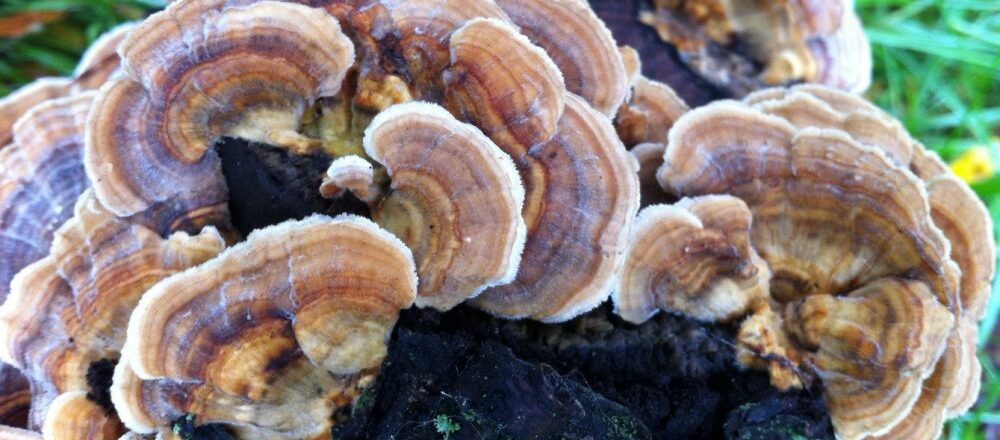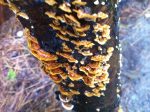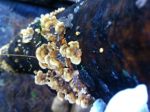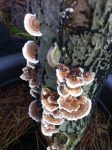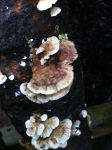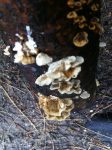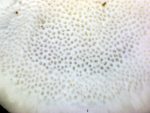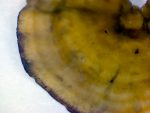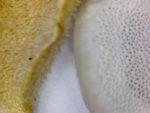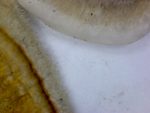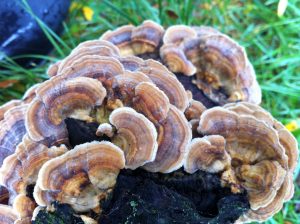 A lot of research has been done, and much written, about the benefits of Trametes versicolor, AKA Turkey Tail. There are many of reports of traditional use, as well as modern scientific studies reporting it contains anticancer, and immune boosting, polysaccharides.
A lot of research has been done, and much written, about the benefits of Trametes versicolor, AKA Turkey Tail. There are many of reports of traditional use, as well as modern scientific studies reporting it contains anticancer, and immune boosting, polysaccharides.
According to Robert Rogers’ The Fungal Pharmacy its Medicinal Properties include antibacterial, anti-inflammatory, antioxidant, anti-tumor, antiviral, cardiovascular tonic, cholesterol modulator, immune tonic, kidney tonic, liver tonic. Anticancer Activity for breast, cervical, esophagus, gastric, leukemia, liver, lung, lymphoma, melanoma, rectal/colon and skin. Antiviral Activity against HIV and Antimicrobial Activity against Aspergillus spp, Candida albicans, Escherichia coli, and Plasmodium spp
Famously, Paul Stamets has claimed his mother was cured of cancer using Turkey Tail, and it has been approved by the FDA for that purpose. It can be chewed whole, eaten ground, or made into a tea, or a tincture.
Turkey Tail is a very common fungus. It is a wood decomposing bracket that grows on almost any kind of dead wood. It is zonate, meaning it has separate concentric color zones, and they come in a range of colors from brown to red. Two different samples can look quite different.
To complicate things there are some look-alikes. Trichaptum abietinum and Stereum hirsutum for example. A friend asked for help identifying a specimen and after a bit of research I realized I had a log with all three on it, which I had assumed were all Turkey Tail. I didn’t see any mention of these fungi being poisonous, but neither are they medicinal or nutritious, so how do we avoid them?
While they look similar on top, they are different below.
- Stereum hirsutum (false turkey tail) top
- Stereum hirsutum (false turkey tail) bottom
- Trametes versicolor (turkey tail) foreground and Stereum hirsutum (false turkey tial) bottom
- Trametes versicolor (turkey tail) top
- Trichaptum abietinum top
- Trichaptum abietinum bottom
The true Turkey Tail is white underneath an has pores in the surface, visible to the naked eye (or with glasses in my case) The False Turkey Tail (Stereum hirsutum ) is yellow and, as a “crust fungus”, it is smooth. The Trichaptum abietinum looks like a faded Turkey Tail and has a toothy surface underneath.
Under the microscope at 20X the differences are more clear.
- Trametes versicolor (turkey tail) bottom
- Stereum hirsutum (false turkey tail) bottom
- Trichaptum abietinum bottom
- Trametes versicolor (turkey tail) vs Trichaptum abietinum bottom
- Stereum hirsutum (false turkey tail) top
- Trametes versicolor (turkey tail) vs Trichaptum abietinum top
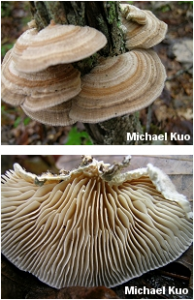
I don’t have a specimen, but there is a third look-alike, Lenzites betulina , which is distinguished from all of the above by having gills. Picture of Lenzites betulina by Michael Kuo
